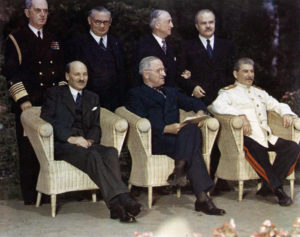
British Prime Minister Clement Attlee, US President Harry S. Truman, and Soviet Premier Joseph Stalin, Potsdam, July 1945 [Public domain, wiki]
Three countries participated: The Soviet Union—represented by Joseph Stalin, the United States—represented by Harry S. Truman (who had become president following the death of President Roosevelt), and Great Britain—represented at first by Winston Churchill and then by Clement Atlee, who became prime minister as a result of the Labour Party winning the July 1945 general election.
The continuation of the war against Japan was a major item on the agenda. So was the re-organization of post-war Europe, including moving the boundary of Poland westward into Germany.
Meanwhile, a top-secret telegram was sent from Washington to Potsdam, to inform the US Secretary for War, Henry Stimson, that the atomic bomb had been successfully tested at Alamogordo in New Mexico.
